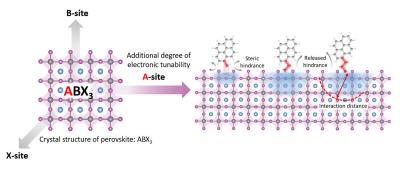Researchers from UCLA, NREL, The University of Toledo, Yangzhou University, Soochow University, Monash University and Lawrence Berkeley National Laboratory, have found that perovskites have a previously unutilized molecular component that can further tune the electronic property of perovskites.
 Schematic of perovskite material with organic molecules that can add to its electronic properties. Credit: Jingjing Xue and Rui Wang/UCLA Samueli School of Engineering
Schematic of perovskite material with organic molecules that can add to its electronic properties. Credit: Jingjing Xue and Rui Wang/UCLA Samueli School of Engineering
Perovskite materials have a crystal-lattice structure of inorganic molecules like that of ceramics, along with organic molecules that are interlaced throughout. Up until now, these organic molecules appeared to only serve a structural function and would not directly contribute to perovskites' electronic performance.
"This is like finding an old dog that can play new tricks," said Yang Yang, from the UCLA Samueli School of Engineering, the principal investigator on the research. "In materials science, we look all the way down to the atomic structure of a material for efficient performance. Our postdocs and graduate students didn't take anything for granted and dug deeper to find a new pathway."
In order to make a better-performing perovskite material, the researchers incorporated a specially designed organic molecule, a pyrene-containing organic ammonium. On its exterior, the positively charged ammonium molecule connected to molecules of pyrene'a quadruple ring of carbon atoms. This molecular design offered additional electronic tunability of perovskites.
"The unique property of perovskites is that they have the advantage of high-performance inorganic semiconductors, as well as easy and low-cost processability of polymers," said study co-lead author Rui Wang, a UCLA postdoctoral scholar in materials science and engineering. "This newly enhanced perovskite material now offers opportunities for improved design concepts with better efficiency."
To demonstrate perovskites' added effectiveness, the team built a photovoltaic cell prototype with the materials, and then tested it under continuous light for 2,000 hours. The new cell continued to convert light to energy at 85% of its original efficiency. This contrasts with a PV cell made of the same materials, but without the added altered organic molecule, which retained only 60% of its original efficiency.

